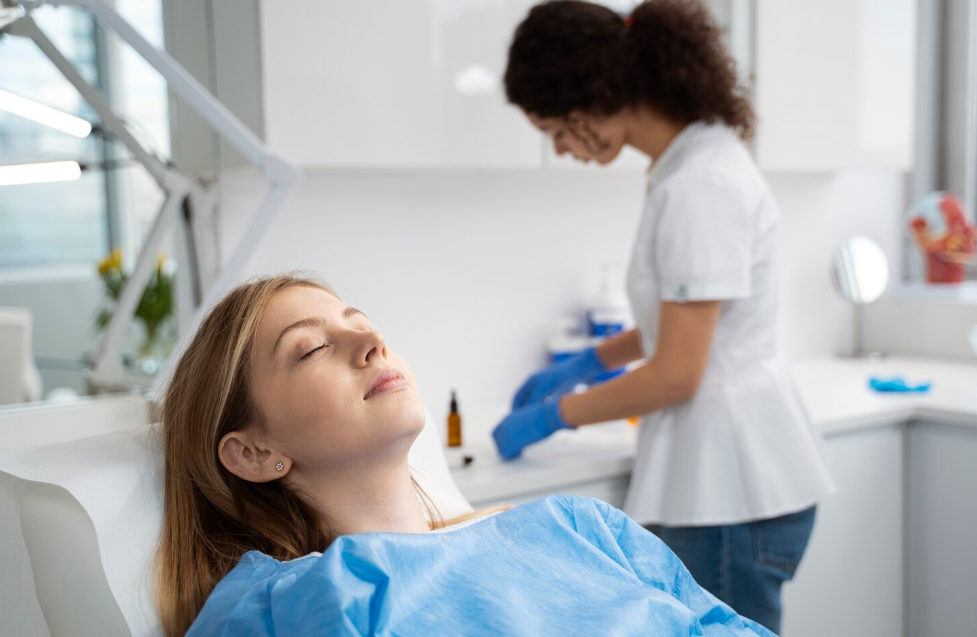Treatment Overview
Fractional CO₂ Laser is one of the most advanced skin resurfacing and regenerative laser treatments in Korean dermatology. It works by creating microscopic controlled injuries (microthermal zones) in the skin, which stimulate the body’s natural healing response, leading to collagen remodeling, dermal thickening, and skin renewal.
For thin or thinning skin, Fractional CO₂ Laser is highly effective in rebuilding dermal density, improving elasticity, and reducing fine lines. It strengthens fragile skin, smooths wrinkles, and enhances firmness over time. In Korea, it is often combined with Rejuran, PRP, or Exosome Therapy to speed up healing and maximize results.
Purpose & Benefits
- Dermal Thickening: Rebuilds skin density and strengthens thin, fragile skin.
- Collagen Remodeling: Boosts collagen and elastin for long-term firmness.
- Texture Refinement: Smooths roughness caused by thinning skin.
- Wrinkle Reduction: Softens fine lines from aging and UV exposure.
- Elasticity Improvement: Restores resilience and youthful bounce.
- Skin Renewal: Promotes healthier, stronger, and more radiant skin.
- Synergy: Often paired with PRP, Rejuran, or Exosomes for regenerative repair.
Ideal Candidates
Fractional CO₂ Laser in Korea for thin skin and skin thinning is recommended for:
- Adults with fragile, thinning skin due to aging or sun exposure.
- Patients with wrinkles, fine lines, or rough texture.
- Those seeking long-term skin strengthening beyond surface hydration.
Comparison with other treatments:
- Fractional CO₂ Laser: Best for structural dermal repair and collagen remodeling.
- Rejuran Healer: Best for DNA-level repair and elasticity.
- Exosome Therapy: Best for cellular regeneration.
- Dermashine Water Glow: Best for hydration and nutrient delivery.
- Collagen Stimulating Fillers: Best for long-term structural thickening.
Possible Risks & Complications
Fractional CO₂ Laser is safe in expert Korean clinics, but may involve:
- Redness & Swelling: Common for 3–7 days post-treatment.
- Dryness & Peeling: Skin renewal phase lasting 5–10 days.
- Temporary Darkening: Post-inflammatory pigmentation may occur in some skin types.
- Rare Risks: Prolonged redness or scarring (rare when done by specialists).
Surgical Techniques Used
- Fractional Delivery: Laser energy delivered in microthermal columns, leaving healthy skin around treated zones to speed healing.
- Custom Depth & Density: Adjusted for mild to severe thinning.
- Collagen Induction: Stimulates dermal regeneration for long-term thickening.
- Combination Therapy: Frequently layered with PRP, Rejuran, or Exosome infusions.
- Protocol: 2–3 sessions every 6–8 weeks; annual touch-ups recommended.
Recovery & Aftercare
- Immediately: Redness, swelling, and heat sensation.
- 3–7 Days: Dryness, peeling, or scabbing as skin renews.
- 2–4 Weeks: Smoother, firmer skin with improved thickness.
Aftercare Tips:
- Apply soothing ointments and healing creams.
- Strict SPF 50+ daily to prevent rebound pigmentation.
- Avoid makeup for 48 hours post-treatment.
- Stay away from saunas, heat, and harsh exfoliation until healed.
Results & Longevity
- Short-Term (2–4 Weeks): Brighter, smoother, and firmer skin.
- Medium-Term (2–3 Months): Increased dermal thickness and improved elasticity.
- Long-Term: Results last 1–2 years; maintenance sessions recommended annually.
Treatment Process in Korea
- Consultation & Skin Analysis – Doctor assesses skin thinning severity.
- Preparation – Cleansing and numbing cream applied.
- Fractional CO₂ Laser Session – Controlled micro-injuries delivered across thinning skin.
- Optional Add-Ons – PRP, Rejuran, or Exosome therapy for enhanced healing.
- Post-Care – Cooling masks, LED light therapy, or antioxidant serums.
- Follow-Up – Multi-session plan for long-term strengthening.
Why Korea is a Top Destination
- Korea is globally renowned for laser resurfacing and regenerative dermatology protocols.
- Clinics use FDA/KFDA-approved CO₂ devices designed for safety and precision.
- Dermatologists often combine CO₂ laser with injectables or exosomes for deeper repair.
- More cost-effective compared to Western clinics.
- Seoul is a leader in skin rejuvenation and anti-aging technology.
Cost Range (Detailed Breakdown)
Pricing for Fractional CO₂ Laser in Korea for thin skin:
- Single Session (Full Face): USD 250 – 500
- 2–3 Session Package (recommended): USD 700 – 1,200
- CO₂ + PRP/Rejuran/Exosome Combo: USD 500 – 900 per session
- Premium Regenerative Package (CO₂ + PN Boosters + Exosomes + PRP): USD 2,500 – 4,000
Additional Costs in Korea:
- Consultation: USD 20 – 50
- Add-ons (Exosomes, Rejuran, PRP): USD 100 – 500
💡 Patients often call Fractional CO₂ Laser the “skin rebuilding laser”, since it restores dermal thickness and resilience while repairing UV and age-related thinning.
Popular Clinics in Seoul
- Banobagi Dermatology – CO₂ + Rejuran for dermal regeneration.
- Oracle Dermatology – CO₂ + PRP for skin strengthening.
- Renewme Skin Clinic – Specializes in CO₂ for thin and fragile skin.
- View Plastic & Dermatology – CO₂ + Exosomes for faster healing.
- Chaum Anti-Aging Center – Premium CO₂ + multi-step regenerative protocols.




